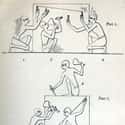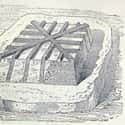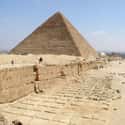-
(#3) The Egyptians Used An Ingenious Technique To Cut Granite Into Blocks
Quarrying the rock-hard granite out of the earth and cutting it to shape is a difficult process even in the modern era, so archaeologists have long wondered how the ancient Egyptians managed to pull it off. The most compelling theories - backed by physical evidence - point to an ingenious method in which workers punched a series of holes in the rock with iron chisels, then stuffed those holes with wooden wedges.
The wedges were drenched with water, making them expand until they split the rock. Then, the Egyptians went to work on those fissures with their chisels until the granite got cut into a block.
-

(#6) Quarry Ramps Were Perhaps Used To Create A Complex Pulley System
The ramp-and-rope system uncovered in an ancient Egyptian alabaster quarry - which hints at how pyramid materials were brought up to ground level - might also provide valuable evidence for how such large stone blocks were elevated in general: pulleys.
By flanking ramps with a series of poles, workers could attach ropes to the blocks, then pull them downhill, with the poles acting as the axles in this iteration of simple machinery.
One of the few solid theories for how this ancient culture was able to lift impossibly large objects into the air entails multiple workers yanking on many simple pulleys to utilize the power of physics.
-

(#4) The Egyptians' Deep Knowledge Of Physics Led To An Inventive Use Of Simple Machines
Little documentation exists to explain how ancient Egyptians built the pyramids, but evidence that has survived to the modern era - including hieroglyphs and the papyrus diary of a worker called "Merer" - hints at a culture with a deep understanding of physics.
Through their advanced knowledge of the laws of the universe, the ancient Egyptians were able to take the same "simple machines" elementary school students learn about today and apply them on a grand scale.
They didn't need advanced technology to transport tons of granite across miles of desert - instead, they merely required the use of basic technology with creativity and ingenuity.
-
(#11) Scientists Disagree About The Design Of Ramps Used To Lift Blocks
Workers implemented ramps to pull granite blocks out of ancient Egyptians quarries, and most Egyptologists agree the ramps likely helped elevate the blocks into place once they reached the construction site of the pyramids. What they don't agree on, however, is the design of said ramps.
There are numerous proposed models of these ramps, each with a set of pros and cons, ranging from simple to uncharacteristically complex. Little evidence has turned up to point researchers in any particular direction to solve this mystery.
-

(#10) Lighter Blocks Were Floated From Canals To The Nile
An Egyptian official's papyrus diary recently uncovered by archaeologists references a series of canals connected to the Nile. These canals were used to float blocks of up to 15 tons to Giza, though heavier stones still needed to be hauled across the land.
According to the diary, wooden boats lashed together with ropes assisted in ferrying granite and limestone from Tura to Giza. The canals were functional only during the summer season when the Nile had flooded.
Their design was sophisticated enough to allow for the creation of artificial ports, including one conveniently close to the pyramid worksites.
-
(#14) Simple Machines Might Have Avoided The Long-Theorized Need For Dubious Sources Of Labor
Popular convention has long held that the sheer labor of hundreds of thousands of enslaved persons went into building the pyramids. This myth goes as far back as the histories of Herodotus, but modern archaeological discoveries turn the notion on its head. Evidence from the mud-brick tombs of the workers who built the pyramids suggests the builders were smaller in number and of a higher social status than previously believed.
According to researchers, the total number of builders was probably around 10,000, a significantly smaller amount than the hundreds of thousands previously reported. Combined with the archaeological evidence of several simple machines used in the extraction and transportation of granite, this new information paints a clear picture of ancient Egyptians using basic technology and ingenuity - not captives - to construct the pyramids.
New Random Displays Display All By Ranking
About This Tool
The Egyptian pyramids are the tombs of Pharaoh, the ruler of ancient Egypt more than 4,500 years ago. The ancient Egyptians believed that life is a short stay, and can only be enjoyed forever after death. Therefore, the pharaoh would spend decades building his pyramid. Facing these giant tombs of tens of meters or even hundreds of meters, archaeologists tried to obtain more information to understand why the ancient Egyptians had such superb construction skills thousands of years ago.
Pharaoh Khufu’s Pyramid is the largest. There is no cement, but it is built of stones. The average weight of the stones used to build the pyramid is 2.5 tons, and it is still difficult to insert a sharp blade into the gap between the stones. The unsolved mysteries about the Egyptian pyramids are also creepy. The random tool shows 14 details about how ancient Egyptians transported blocks to build pyramids.
Our data comes from Ranker, If you want to participate in the ranking of items displayed on this page, please click here.













